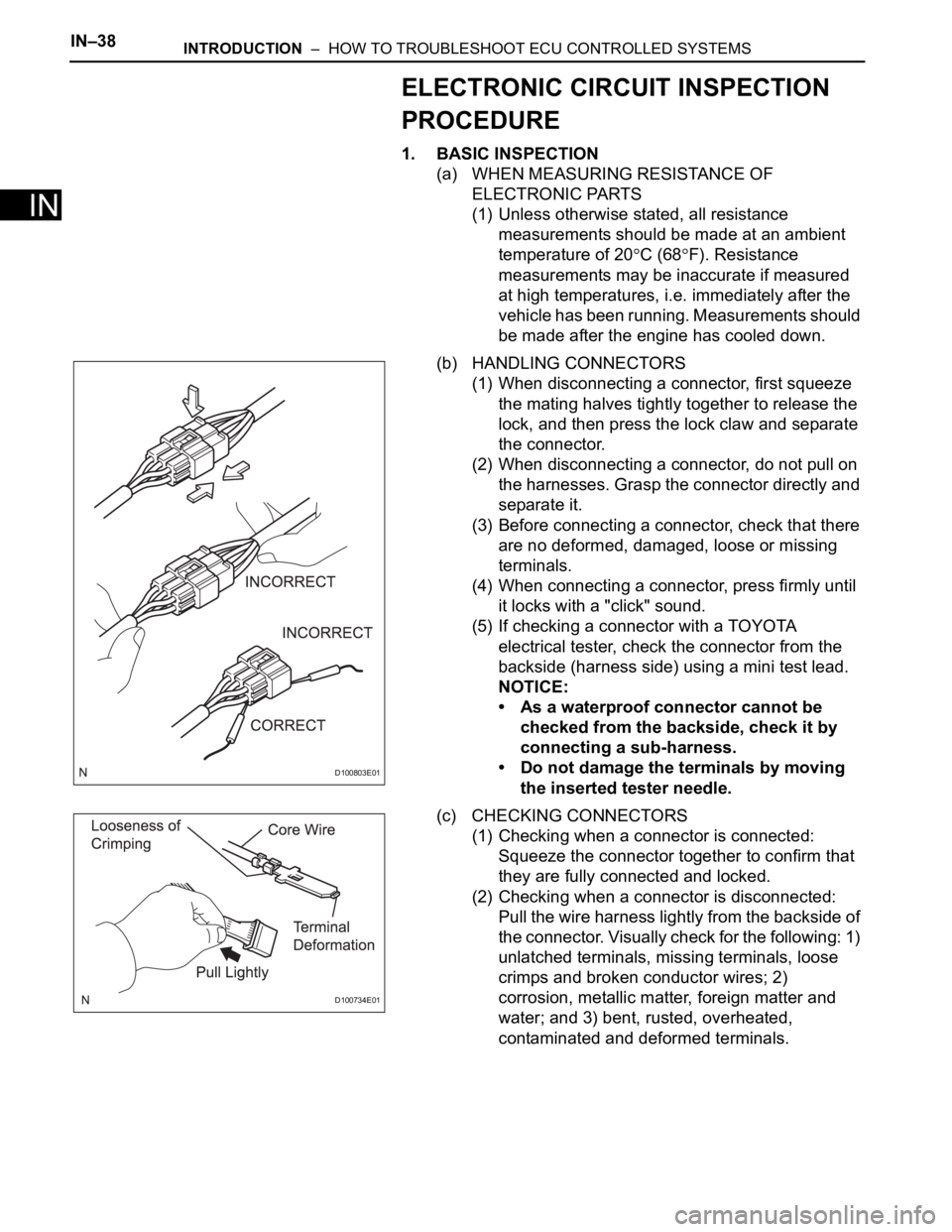Page 66 of 2000

ENGINE - 2AZ-FE ENGINE
01MEG02Y
Valve Timing : Intake Valve Opening Angle
: Exhaust Valve Opening Angle
VVT-i Operation
Range
VVT-i Operation
RangeTDC
3
3
43
65
25
45
BDCEG-3
Engine Specifications
No. of Cyls. & Arrangement4-cylinder, In-line
Valve Mechanism16-valve DOHC, Chain Drive (with VVT-i)
Combustion ChamberPentroof Type
ManifoldsCross-flow
Fuel SystemSFI
Ignition SystemDIS
Displacement cm3 (cu. in.)2362 (144.1)
Bore x Stroke mm (in.)88.5 x 96.0 (3.48 x 3.78)
Compression Ratio9.8 : 1
Max. Output*1(SAE-NET)124 kW @ 6000 rpm (166 HP @ 6000 rpm)
Max. Torque*1(SAE-NET)224 N.m @ 4000 rpm (165 ft-lbf @ 4000 rpm)
IntakeOpen3 - 43 BTDC
Valve Timing
IntakeClose65 - 25 ABDCVa l v e T i m i n g
ExhaustOpen45 BBDCExhaustClose3 ATDC
Firing Order1 - 3 - 4 - 2
Research Octane Number91 or higher
Octane Rating87 or higher
Oil GradeILSAC
Tailpipe Emission RegulationULEV-II, SFTP
Evaporative Emission RegulationLEV-II, ORVR
Engine Service Mass*2 (Reference) kg (lb)138 (304.2)
*1: Maximum output and torque rating is determined by revised SAE J1349 standard.
*
2: Weight shows the figure with oil and water fully filled.
Page 70 of 2000

ENGINE - 2GR-FE ENGINE
285EG08 285EG07
Intake
Va l v e
Spark
Plug
Hole
Exhaust
Va l v eIntake Side
Exhaust SideCamshaft Housing
Exhaust
SideIntake
Side
Upright
Intake Port
Taper Squish A
A
View from Back Side A - A Cross Section
215EG19 215EG18
Siamese Type Independent Type EG-74
3. Cylinder Head
The cylinder head structure has been simplified by separating the cam journal portion (camshaft housing)
from the cylinder head.
The cylinder head, which is made of aluminum, contains a pentroof-type combustion chamber. The spark
plug is located in the center of the combustion chamber in order to improve the engine’s anti-knocking
performance.
The intake ports are on the inside and the exhaust ports are on the outside of the left and right banks
respectively.
Upright intake ports are used to improve the intake efficiency.
A taper squish combustion chamber is used to improve anti-knocking performance and intake efficiency.
In addition, engine performance and fuel economy have been improved.
The siamese type intake port is used to reduce the overall surface area of the intake port walls. This
prevents the fuel from adhering onto the intake port walls, thus reducing HC exhaust emissions.
— REFERENCE —
Page 131 of 2000

ENGINE - 2GR-FE ENGINEEG-69
Engine Specifications
No. of Cyls. & Arrangement6-cylinder, V Type
Valve Mechanism24-valve DOHC, Chain Drive (with Dual VVT-i)
Combustion ChamberPentroof-type
ManifoldsParallel-flow
Fuel SystemSFI
Ignition SystemDIS
Displacement cm3
(cu. in.)3456 (210.9)
Bore x Stroke mm (in.)94.0 x 83.0 (3.70 x 3.27)
Compression Ratio10.8 : 1
Max. Output (SAE-NET)*1201 kW @ 6200 rpm (269 HP @ 6200 rpm)
Max. Torque (SAE-NET)*1333 N.m @ 4700 rpm (247 ft.lbf @ 4700 rpm)
Intake ValveOpen-3 to 37 BTDC
Valve Timing
Intake ValveClose71 to 31 ABDCVa l v e T i m i n g
Exhaust ValveOpen60 to 25 BBDCExhaust ValveClose4 to 39 ATDC
Firing Order1 - 2 - 3 - 4 - 5 - 6
Octane Rating91 or higher
Engine Oil GradeILSAC multigrade engine oil
CaliforniaULEVII, SFTP
EmissionTailpipeExceptTier2 Bin5 SFTPEmission
Regulation
ppExcept
CaliforniaTier2-Bin5, SFTPg
EvaporativeLEVII, ORVR
Engine Service Mass*2 (Reference) kg (lb)163 (359)
*1: Maximum output and torque rating is determined by revised SAE J1349 standard.
*
2: Weight shows the figure with the oil and engine coolant fully filled.
Page 215 of 2000

IN–38INTRODUCTION – HOW TO TROUBLESHOOT ECU CONTROLLED SYSTEMS
IN
ELECTRONIC CIRCUIT INSPECTION
PROCEDURE
1. BASIC INSPECTION
(a) WHEN MEASURING RESISTANCE OF
ELECTRONIC PARTS
(1) Unless otherwise stated, all resistance
measurements should be made at an ambient
temperature of 20
C (68F). Resistance
measurements may be inaccurate if measured
at high temperatures, i.e. immediately after the
vehicle has been running. Measurements should
be made after the engine has cooled down.
(b) HANDLING CONNECTORS
(1) When disconnecting a connector, first squeeze
the mating halves tightly together to release the
lock, and then press the lock claw and separate
the connector.
(2) When disconnecting a connector, do not pull on
the harnesses. Grasp the connector directly and
separate it.
(3) Before connecting a connector, check that there
are no deformed, damaged, loose or missing
terminals.
(4) When connecting a connector, press firmly until
it locks with a "click" sound.
(5) If checking a connector with a TOYOTA
electrical tester, check the connector from the
backside (harness side) using a mini test lead.
NOTICE:
• As a waterproof connector cannot be
checked from the backside, check it by
connecting a sub-harness.
• Do not damage the terminals by moving
the inserted tester needle.
(c) CHECKING CONNECTORS
(1) Checking when a connector is connected:
Squeeze the connector together to confirm that
they are fully connected and locked.
(2) Checking when a connector is disconnected:
Pull the wire harness lightly from the backside of
the connector. Visually check for the following: 1)
unlatched terminals, missing terminals, loose
crimps and broken conductor wires; 2)
corrosion, metallic matter, foreign matter and
water; and 3) bent, rusted, overheated,
contaminated and deformed terminals.
D100803E01
D100734E01
Page 457 of 2000
DL–108DOOR LOCK – DOOR CONTROL RECEIVER
DL
INSTALLATION
1. INSTALL DOOR CONTROL RECEIVER
(a) Install the receiver with the bolt.
(b) Connect the receiver connector.
2. INSTALL INNER ROOF SIDE GARNISH ASSEMBLY
RH (w/o Rear No. 2 Seat)
(a) Attach the 7 clips to install the garnish.
3. INSTALL INNER ROOF SIDE GARNISH ASSEMBLY
RH (w/ Rear No. 2 Seat)
(a) Attach the 7 slips to install the garnish.
(b) Connect the rear No. 2 seat belt's shoulder anchor.
(1) Connect the shoulder anchor with the bolt.
Torque: 42 N*m (428 kgf*cm, 31 ft.*lbf)
(2) Attach the claws to close the seat belt anchor
cover.
4. INSTALL DECK TRIM SIDE PANEL ASSEMBLY RH
(w/o Rear No. Seat) (See page IR-53)
5. INSTALL DECK TRIM SIDE PANEL ASSEMBLY RH
(w/ Rear No. 2 Seat) (See page IR-54)
B132568
B137548
B137549
B084915E06
Page 522 of 2000
INTERIOR – ROOF HEADLININGIR–13
IR
COMPONENTS
(2006/01- )
B131878E02
Page 523 of 2000
IR–14INTERIOR – ROOF HEADLINING
IR
B131879E02
Page 524 of 2000
INTERIOR – ROOF HEADLININGIR–15
IR
B131939E02